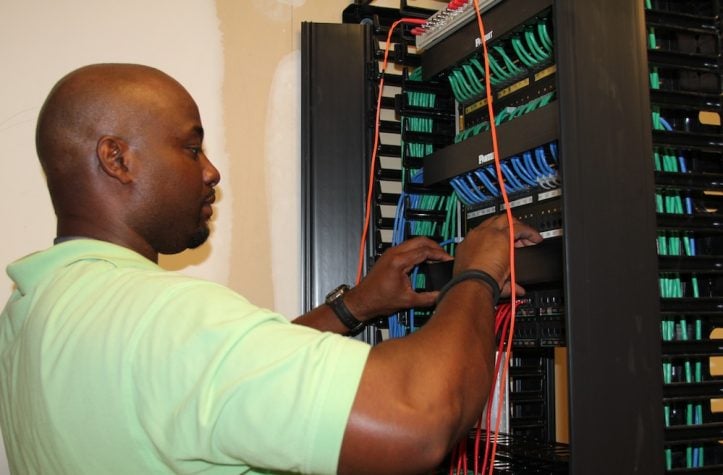AISD begins upgrading wireless infrastructure at schools

Oct. 29, 2015 - Technology has become ubiquitous, even in the classroom. And with the AISD encouraging teachers to use technology as innovative educational tools and also providing ample access for students to wireless devices like iPads and Chromebooks – paid for with bond funds – the demand for wireless coverage is exploding. But offering ample high-speed wireless requires strong infrastructure in each school. So using 2014 Bond package funds, the AISD network services department is working to improve each school’s infrastructure with better equipment and many additional wireless data access points, which together will provide the bandwidth and stability needed.
The infrastructure work began last week at Swift Elementary, the first AISD school to receive the upgrades. While all campuses will get the upgrades, the district is starting with a group of 18 schools.
The first 18 schools were selected based on a multi-year replacement schedule involving all campuses, and E-Rate funds were secured to assist in purchasing the equipment. E-Rate is a federal program that enables school districts to purchase telecommunications and Internet equipment at significantly reduced rates.
Daniel O’Farrell, AISD network specialist, and his co-workers spent last Wednesday installing the new equipment in Swift’s MDF (main distribution frame) closet and IDF (intermediate distribution frame) closets. In the MDF, they replaced an eight-year-old router. The router “provides connection to the Internet, network systems … basically to everything,” explained O’Farrell. This new equipment will make those connections much faster, he said, with speeds of 1 GB – ten times faster than before.
The new router also provides the connections through the AISD cloud. If one of the AISD’s data centers goes down for any reason, the school will simply switch its connection through the cloud to a different data center, preventing any interruption in service. It’s about keeping the teachers’ networks up and running, O’Farrell said, so they can keep on teaching without any disruptions.
The MDF closet also has an SRST (survivable remote site telephony) router, which provides a direct backup line for emergency service. If for some reason the school’s basic phone connection is lost, the SRST router will provide 9-1-1 service.
The network services team also upgraded the switches and equipment in the IDF closets. The router in the MDF provides Internet and network service to the school, but the cables that run from the MDF to each room are limited in length to 328 feet. So IDF closets, positioned throughout the schools, extend that length. The cables from the MDF run to the IDF and connect through switches to new cables, which then run from the IDF to the farthest classrooms.
All those cables run to access points throughout the school, which then disseminate the wireless signal. Over two nights last week, subcontractor DataStar replaced old access points and added many more. Most of the new access points have a four-radio array and can handle 25 to 35 devices at a time. Prior to the installation, a heat map was generated to display the wireless coverage in the school. From the map, the network services department determined where additional access points were needed. Now every classroom, along with all common areas, have access points mounted in the ceiling. Wireless coverage is also provided outside for key areas of the campus grounds. As O’Farrell explained, now you won’t have to fight with anyone else for bandwidth.
Now that Swift is complete, the network services department will move on to Sherrod Elementary next week, and then continue upgrading the remainder of the first 18 schools, completing one per week.
